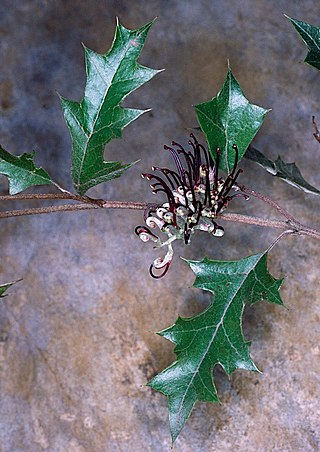Top Qs
Timeline
Chat
Perspective
Grevillea scortechinii
Species of shrub in the family Proteaceae endemic to Queensland and New South Wales Australia From Wikipedia, the free encyclopedia
Remove ads
Grevillea scortechinii, commonly known as black grevillea,[2][3] is a species of flowering plant in the family Proteaceae and is endemic to eastern Australia. It is a prostrate to sprawling shrub with serrated to pinnatifid leaves, the end lobes broadly triangular and often sharply-pointed, and clusters of brown flowers with a dark purplish-black style. There are two subspecies, subsp. scortechinii found in Queensland and subsp. sarmentosa, found in New South Wales.

Remove ads
Description
Grevillea scortechinii is a prostrate to sprawling shrub that typically grows up to 0.8 m (2 ft 7 in) high and 1.2 m (3 ft 11 in) wide. Its leaves are egg-shaped to oblong in outline, 30–110 mm (1.2–4.3 in) long and 20–60 mm (0.79–2.36 in) wide but serrated to pinnatifid with 3 to 14 lobes or broad teeth that are sometimes further divided, the end lobes rounded, to broadly triangular and up to 20 mm (0.79 in) long and sometimes sharply pointed. The lower surface of the leaves is silky-hairy. The flowers are borne on one side of a rachis 20–45 mm (0.79–1.77 in) long and brown, the style purplish black with a green pollen presenter. The flower stalk is 1.0–1.6 mm (0.039–0.063 in) long and the pistil 19–22 mm (0.75–0.87 in) long. Flowering time varies with subspecies and the fruit is a silky-hairy follicle 8.5–12 mm (0.33–0.47 in) long.[4]
Remove ads
Taxonomy
Summarize
Perspective
This grevillea was first formally described in 1883 by Benedetto Scortechini in the Proceedings of the Linnean Society of New South Wales from an unpublished description by Ferdinand von Mueller who gave it the name Grevillea ilicifolia var. scortechinii.[5][6] In 1889, von Mueller raised the variety to species status as G. scortechinii in the Second Systematic Census of Australian Plants.
In 1989, Donald McGillivray described two subspecies of G. scortechinii and the names are accepted by the Australian Plant Census:
- Grevillea scortechinii subsp. sarmentosa (Blakely & McKie) McGill.,[7] (previously known as G. sarmentosa) has leaf lobes that are often further divided, and lack conspicuous veins on the upper surface, the pistil 19–22 mm (0.75–0.87 in) long and the flower stalk 1.0–1.6 mm (0.039–0.063 in) long. Flowering occurs from February to March.[2][8][9]
- Grevillea scortechinii (F.Muell. ex Scort.) F.Muell. subsp. scortechinii,[10] has leaf lobes that are usually not further divided, and have conspicuous veins on the upper surface, the pistil 28–30 mm (1.1–1.2 in) long and the flower stalk 2.0–2.6 mm (0.079–0.102 in) long. Flowering occurs in October and November.[9][11]
Remove ads
Distribution and habitat
Black grevillea grows in woodland often on granite or in remnant roadside vegetation. Subspecies sarmentosa occurs near Guyra in New South Wales and subsp. scortechenii between Stanthorpe and Cottonvale in Queensland.[8][11]
Conservation status
Subspecies sarmentosa is listed as "vulnerable" under the New South Wales Government Biodiversity Conservation Act and subsp. scortechenii is listed as "critically endangered" under the Australian Government Environment Protection and Biodiversity Conservation Act 1999.
References
Wikiwand - on
Seamless Wikipedia browsing. On steroids.
Remove ads

